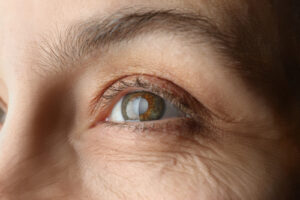
When people think of eye diseases, it’s fairly common for patients to think of cataracts. Ironically, cataracts aren’t considered a health concern. Everyone gets cataracts if they live a long healthy life.
They develop slowly over time and are one of the most common ocular conditions, affecting more than twenty-four million people in the United States. However, just because they aren’t a health concern doesn’t mean they’re not visually disturbing.
Are you wondering if you have a cataract? If you’re sixty or older and experiencing issues with blurred vision, increased glare or halos, or struggling to read without needing extra light, chances are that you could have cataracts.
However, because cataracts develop slowly over time, you may not have any apparent symptoms. To be thorough, it’s always a good idea to get your vision, and ocular health checked at a routine eye exam to rule out any changes.
That way, if you aren’t noticing symptoms, cataracts, as well as other ocular concerns, can be on your radar which allows for quicker intervention when needed. Since cataracts will affect everyone eventually, it’s well worth it to be informed.
Keep reading to learn more about what a cataract is and how your optometrist diagnoses them!
What Is a Cataract?
The are several important structures that make up your eye. One of those structures is called the lens or the crystalline lens.
This structure, along with the cornea, helps refract light onto a point of your retina and allows the eye to focus on objects at varying distances. This structure is curved, usually transparent, and located behind the iris.
 The lens changes shape, which aids in transmitting light to the retina in the back of your eye. When the natural lens becomes clouded as a part of the natural aging process, it’s called a cataract.
The lens changes shape, which aids in transmitting light to the retina in the back of your eye. When the natural lens becomes clouded as a part of the natural aging process, it’s called a cataract.
Cataracts block light and prevent that light from reaching the retina, which in turn causes blurred or clouded vision. There are several different types of cataracts, but the vast majority of them are considered age-related.
As you get older, proteins in the lenses start to break down and form clumps. These worsen over time and eventually block out light.
Age-related cataracts typically start forming in your sixties and continue to develop until they are removed. Some infants are born with cataracts, and these are considered congenital cataracts.
Others develop cataracts after an injury. Other factors that play into the growth of cataracts include UV exposure, smoking, steroid medications, and certain systemic condition such as diabetes and high blood pressure.
What Are the Most Common Signs and Symptoms of a Cataract?
As a reminder, cataracts develop gradually. You may not notice any symptoms at first. However, as the cataract continues to grow, become denser, and begin to block more light, it can affect your vision in several ways.
One of the most common signs of a cataract is blurred or distorted vision. It is often described as constantly looking through a dirty or foggy window; no matter what you do, you can’t seem to see clearly.
 Patients may struggle with their glasses, feeling like they are less effective. This can be for a couple of reasons.
Patients may struggle with their glasses, feeling like they are less effective. This can be for a couple of reasons.
Changes in cataracts can cause shifts in prescription, which your eye doctor can accommodate with a new glasses or contact lens prescription to help you see a bit more clearly. However, once a cataract reaches a more advanced stage, it doesn’t matter what prescription they put in a pair of glasses.
The cataract will be too dense to see clearly out of. Another common symptom of cataracts is issues with glare or halos off of light sources.
This is especially troublesome during nighttime driving. Patients who have developed cataracts will often note increased concern with nighttime driving to the point that they avoid it because they don’t feel safe.
On the flip side, some patients struggle with needing more light than before, especially for fine detail tasks like reading, sewing, puzzles, or games. Patients report needing bright overhead lights or lamps for specific tasks that they didn’t require previously.
Lastly, cataracts can change the way you see color. This is not as common of a symptom, and most patients don’t realize it until after the cataract has been removed.
However, as cataracts form, vision starts to develop of yellow or brownish tint. Bright colors tend to appear faded, and some patients report that it becomes difficult to distinguish colors, especially blues and purples.
How Does Your Eye Doctor Diagnose a Cataract?
The only way to know for certain whether you’ve developed a cataract is to have it officially diagnosed by your eye doctor. Even when symptoms are minimal or non-existent, it’s important to be aware of those findings so that you and your doctor can monitor their progression and help determine a plan for treatment moving forward.
 Because everyone can get cataracts, the best way to monitor is with routine eye exams. Every time you come in for your annual eye exam, your doctor will check for signs of a cataract with a dilation.
Because everyone can get cataracts, the best way to monitor is with routine eye exams. Every time you come in for your annual eye exam, your doctor will check for signs of a cataract with a dilation.
Other testing might be done to assess the severity of the cataract, and once all the information is gathered, you and your doctors can plan a course of action as needed. If the cataract has gotten to a point where it’s visually concerning and daily tasks have become challenging, we are able to refer you to the best possible surgeons to help you see more clearly and get back to your day-to-day activities.
Blaine Eye Clinic will be there every step of the way to ensure that you have the best possible outcome.
Are you worried that cataracts might be affecting your vision? If so, we would love to check your eyes out and ease your mind of any concerns. Schedule a comprehensive eye health exam at Blaine Eye Clinic in Blaine, Minnesota, today!





